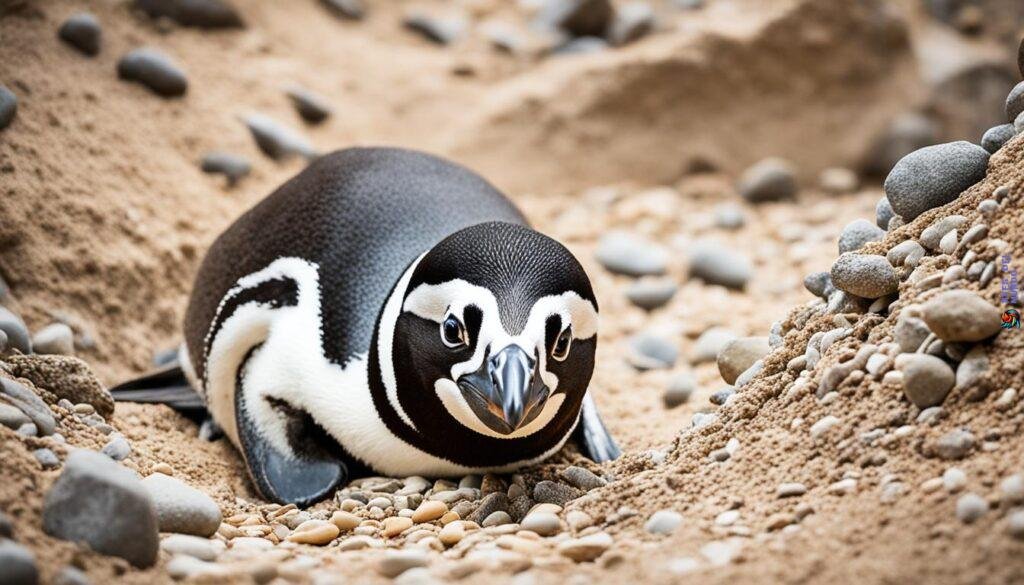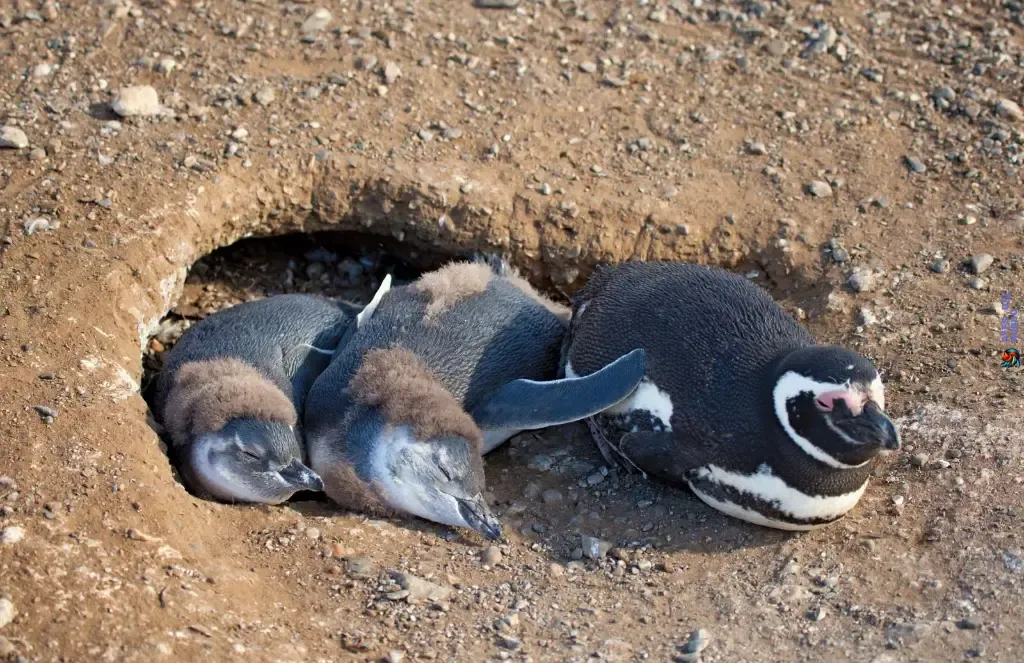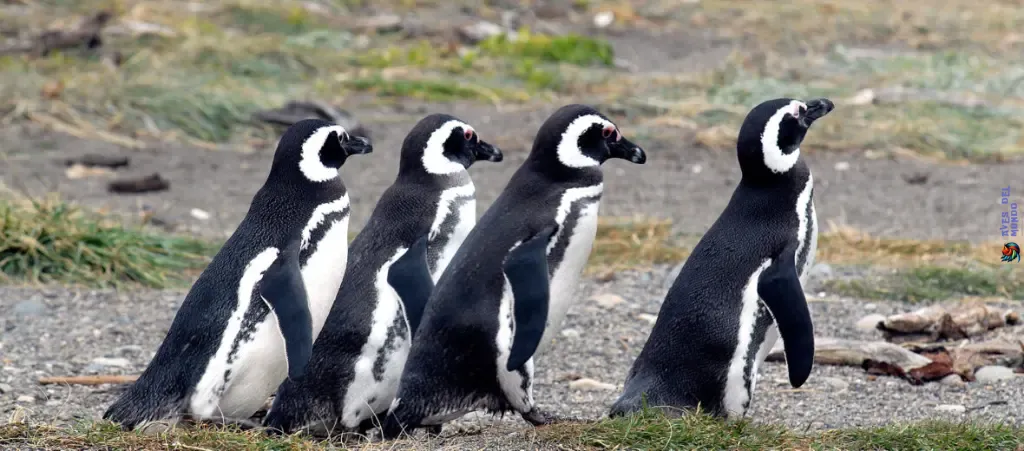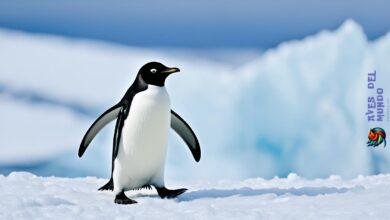Have you ever thought about the amazing lives of Magellanic penguins? These charming coastal birds live along southern South America’s shores. They are a source of fascination for birdwatchers and scientists. With their unique looks and important role in the ocean’s life, they are truly inspiring. Let’s explore the world of these penguins, learning about their home and way of life.
The Magellanic penguin is a medium-sized bird with a distinctive look. They have black and white feathers with two bands on their chest and a white neck strap. These birds are found in the Falkland Islands, Patagonia, and along the coasts of Argentina and Chile. They are known for their elegant swimming in the ocean.

Let’s dive into the life of Magellanic penguins. We’ll look at what they look like, how they find food, where they nest, and the challenges they face. By learning about their special qualities and how they adjust to their habitat, we can understand their importance. We’ll also see why saving these penguins is key to protecting South America’s rich sea life.
Are you eager to learn more about the Magellanic penguin? Join us on this exciting journey. Together, we’ll discover more about these amazing birds who make the coastal areas of South America their home!
Physical Features of Magellanic Penguins
Magellanic penguins are the biggest in the Spheniscus family. They are known for unique looks. These birds are about 24-30 inches tall and weigh 8-14 pounds. They stand out because of their size. Both male and female penguins look alike. They have sleek black backs and bright white bellies.
These penguins have attention-grabbing feathers. They wear two black bands on their chest and a white ring around their neck. These marks make them even more appealing as seashore birds.
Juvenile Magellanic penguins look different from adults. They don’t have the white crescent on their face like adults do. Instead, they have light-colored patches on their cheeks. Their feathers are a mix of brown and white, making them stand out.
To really see how beautiful Magellanic penguins are, look at the picture below:
Diet and Foraging Behavior
Magellanic penguins enjoy a mix in their diet. They mostly eat fish like anchovies, sardines, hake, sprat, and cod. Krill and cephalopods also play a big role in their nutrition.
Magellanic penguins forage as a team. This group hunting makes them better at catching prey. It helps them find food more effectively.
While searching the ocean for food, Magellanic penguins stay alert for dangers. They look out for killer whales, fur seals, sea lions, and giant fulmars.
But it’s not just the ocean that’s risky. On land, their eggs and chicks face threats too. Skuas, gulls, foxes, rats, pumas, and domestic cats can all be dangers. These threats can affect their success in having babies.
This image shows Magellanic penguins foraging together. By swimming in sync, they hunt better and catch more food.
| Prey | Primary Diet |
|---|---|
| Fish | Anchovies, sardines, hake, sprat, cod |
| Krill | Mainly Euphausia superba (Antarctic krill) |
| Cephalopods | Squid, octopus, cuttlefish |
This table lists what Magellanic penguins eat. You can see they eat many types of fish, like anchovies, sardines, hake, sprat, and cod. Krill and cephalopods are also key parts of their diet.
Nesting and Breeding Habits
Magellanic penguins take part in unique nesting and breeding activities. These activities help their species thrive. They choose mates, build homes, and raise their young with great care.
These penguins breed in various places like forests, grasslands, and rocky areas. Such variety makes sure there are enough nesting spots for everyone.
The breeding time starts in September and ends in February. During this period, pairs stick together, showing strong loyalty towards each other.

Building burrows is a special habit of these penguins. They use grasses and bushes to shield their nests. These burrows keep their eggs safe from the weather and predators.
Both parents share the job of warming the eggs for around 40 days. This teamwork boosts the eggs’ chances of hatching. They keep the eggs at the right temperature for growth.
After the eggs hatch, chicks stay in the burrows for 30 days. Their parents feed them by bringing food from the sea. This help is crucial for the chicks to get stronger and grow.
In summary, Magellanic penguins demonstrate unique breeding patterns. They rely on each other to care for their eggs and young. Through their efforts, they ensure their population remains strong.
| Nesting and Breeding Habits of Magellanic Penguins | Description |
|---|---|
| Nesting Preferences | Coastal forests, grasslands, offshore islands, and rocky headlands |
| Breeding Season | Early September to February |
| Monogamous Pairs | Breeding pairs establish long-term monogamous relationships |
| Burrow Construction | Build burrows under tussocks, tall grasses, and bushes for protection |
| Incubation | Both parents take turns incubating the eggs for approximately 40 days |
| Chick Development | Chicks remain in the burrows for the first 30 days, fed by their parents |
Life Cycle and Maturity
Magellanic penguins go through an amazing life journey over several years. They are ready to have babies at about three years old. But most girls start at four and boys at five. Then, they join the effort to grow their colony’s numbers.
These penguins often live to be 20 years old. Some even reach 30, making them among the longer-living penguins. Their long lives mean they have many chances to raise chicks and help their colony grow.
When young penguins get ready for adult life, it’s called the fledging period. This important time lasts up to 60 days. They learn skills essential for survival.
If there’s not much food around, this period can stretch to 120 days. This extra time helps the young ones get better at finding food. It also makes them stronger before they set out on their own.
Maturity Milestones:
- Sexual maturity (approx. 3 years old): At this age, Magellanic penguins are physically ready to engage in breeding activities.
- Fledging period (up to 60 days): During this period, young penguins develop their skills and physical abilities to become self-reliant.
- Extended fledging period (up to 120 days): In colonies with fewer food resources, chicks undergo a longer fledging period to ensure their readiness for independent survival.
| Life Cycle Milestones | Timing |
|---|---|
| Sexual maturity | Around 3 years old |
| Fledging period | Up to 60 days |
| Extended fledging period (in colonies with limited food resources) | Up to 120 days |
| Lifespan | Average of 20 years (some individuals can live up to 30 years) |
Conservation Status and Threats

Magellanic penguins are listed as «near threatened» by the International Union for Conservation of Nature’s Red List. They have 1.1 to 1.6 million breeding pairs worldwide. Yet, they face many dangers.
Some colonies of these birds are growing. But others are getting smaller quickly. This shows we need to act fast to help them.
Oil pollution is a big problem for Magellanic penguins. Oil from ships and drilling can mess up their feathers. This makes it hard for them to stay warm, float, or swim well. Such disasters hurt not just one penguin, but can threaten their whole population.
The fishing industry competes with penguins for fish, which is their main food. When fish become rare, penguins struggle to find food. Getting caught in fishing nets can also kill or hurt them, leading to fewer penguins.
Changes in the ocean’s temperature and currents from El Niño can also harm them. This messes up their food and breeding. When this happens along with other dangers, it’s really bad for their survival.
«Saving Magellanic penguins from these threats is key. We must fight the causes of their decline. This way, we can keep these amazing birds around.»
To help, there are projects that work together to save these penguins. They try to make people aware of the penguins’ troubles. They push for rules to lessen oil spills and want fishing to be done in a way that leaves enough fish for the penguins.
Studying these birds is also crucial. It helps experts know what the penguins need to survive. This info helps them make plans to save the penguins’ homes, their breeding sites, and the sea life they need.
Conservation Status and Threats – Summary:
| Threats | Impact |
|---|---|
| Oil pollution | Potential harm to feathers, reduced ability to swim |
| Fishing industry | Competition for food, accidental capture in fishing nets |
| El Niño/Southern Oscillation events | Disruption of reproductive and food sources |
Unique Traits and Adaptations
Magellanic penguins have special traits and adaptations for life in the ocean. These features help them move through water easily and stay healthy.
- Countershading: The black and white plumage of Magellanic penguins provides countershading, a natural camouflage technique that helps them blend in with the ocean when viewed from above or below. This adaptation allows them to remain inconspicuous and avoid potential predators.
- Streamlined Body: With their streamlined body shape, Magellanic penguins are well-suited for aquatic life. This body structure minimizes drag and resistance, enabling them to swim swiftly and efficiently through the water in search of food.
- Webbed Feet and Long Flippers: The webbed feet and long flippers of Magellanic penguins are essential tools for their aquatic endeavors. These adaptations provide them with excellent propulsion and maneuverability, making them agile swimmers in pursuit of prey.
- Oily Feathers: Magellanic penguins have oily feathers that play a crucial role in their survival. These feathers offer insulation by repelling water, keeping them warm and dry in the cold ocean. The oil also helps maintain their buoyancy while swimming.
Magellanic penguins are perfectly suited for their marine home. Their special body, swimming skills, and oily feathers all help them survive.

The Importance of Adaptations
«The adaptations of Magellanic penguins allow them to excel in their marine environment, providing them with the necessary tools to navigate, hunt, and thrive.» – Marine Biologist, Dr. Amanda Rodriguez
Importance of Magellanic Penguins in the Ecosystem
Magellanic penguins are not just interesting to look at. They play a big part in the ocean’s life. They are food for killer whales, fur seals, and sea lions. This helps keep the food chain balanced. Their search for food helps move nutrients around in the ocean, making them key players in the ecosystem.
These penguins mostly eat small fish and krill found near the coast. By doing this, they help control the number of these animals. This helps spread nutrients around. When they eat fish and krill, they help move nutrients up the food chain.
«The presence of Magellanic penguins in the ecosystem ensures that the predatory species have a sustainable food source. Their role in maintaining the balance of the food web cannot be overstated.»
Magellanic penguins’ poop, or guano, helps the land nearby. It acts like a natural fertilizer. This makes the soil richer and helps coastal plants grow. These plants then provide homes for other creatures, making a richer ecosystem.
We need to protect Magellanic penguins and their role in the ecosystem. By doing so, we help keep the ocean’s life diverse and healthy. Keeping their homes safe and their numbers steady is key to our marine environment’s wellness.
| Importance of Magellanic Penguins in the Ecosystem | |
|---|---|
| Prey Species for Predators | Killer whales, fur seals, and sea lions depend on Magellanic penguins as a vital food source. |
| Nutrient Cycling | The foraging behavior of Magellanic penguins contributes to the distribution of nutrients in the ocean. |
| Natural Fertilizers | The penguins’ guano serves as a nutrient-rich fertilizer, enhancing the fertility of the surrounding environment. |
Conservation Efforts and Research
Many projects aim to protect Magellanic penguins and their homes. They focus on sustainable practices and habitat protection. Research is also a big part of these efforts. It helps ensure the species survives long-term.
One important effort is creating biosphere reserves along the coast. These reserves help penguins breed, nest, and find food. They also reduce the impact of human activities.
Research is key to understanding how humans and climate change affect these penguins. By studying their behaviors and migration, experts can learn what the penguins need. This information guides efforts to keep their habitats safe.
«Through ongoing research, we can better understand the challenges faced by Magellanic penguins and develop targeted conservation measures to address them,» says Dr. Maria Rodriguez, a leading researcher in penguin conservation.
This research doesn’t just help protect the penguins. It also supports the push for policies that keep their breeding and feeding areas safe. By spreading the word about these efforts, the goal is to ensure a sustainable future for these amazing birds.
Conservation Projects
Here are some key conservation projects for Magellanic penguins:
| Project Name | Focus | Location |
|---|---|---|
| The Penguin Protection Project | Habitat restoration, species monitoring | Falkland Islands |
| Marine Conservation Initiative | Sustainable fishing practices | Chilean coast |
| The Penguin Research Foundation | Behavioral studies, education programs | Argentina |
These projects team up with local people, governments, and NGOs. Together, they aim for a future where Magellanic penguins not only survive but flourish. The goal is to keep their homes safe and value their role in nature.
Interaction with Humans
Magellanic penguins draw tourists who want to see these coastal birds in the wild. Watching these penguins closely is an amazing experience. It lets you see their special behaviors as they live along the coast.
Tourism can hugely impact these penguins and their health. Good tourism can teach us and help with conservation. But bad practices can stress and disturb the birds.
Too many tourists can disrupt the penguins’ lives. It can change how they act, affect breeding, and stress them out. Human activity can mess with their feeding, disturb nests, and cause them to leave their eggs or chicks.
Your visit should be careful and respectful. Stay back, use paths or platforms, and be quiet to avoid scaring the penguins.
Our behavior as visitors affects the penguins. Our love should help, not hurt them. Let’s aid in their conservation.
Human actions like oil spills are a big threat to Magellanic penguins. These spills ruin their feathers, which they need to stay warm and swim.
Oil spills are terrible for penguins, killing many each year. This harms not just those penguins but affects all in their ecosystem.
Take Action to Protect Magellanic Penguins
If you’re visiting penguin places, think first about their care and safety. Here’s what you can do:
- Respect viewing spots and keep distance to lessen disturbances.
- Listen to guides or rangers.
- Encourage tourism that protects wildlife.
- Help in beach clean-ups and work to stop oil spills.
- Learn about and support conservation work.
By being thoughtful and supporting conservation, we help protect Magellanic penguins. This way, many can enjoy these special birds in the future.
Future Outlook for Magellanic Penguins
Magellanic penguins face serious issues because of climate change and human actions. Climate change brings about warm ocean waters and harsh weather, hurting the penguins’ chances of survival and finding food.
Moreover, human activities such as overfishing and destroying their habitats add to their troubles. But, saving these unique coastal birds is crucial for their future.
Conservation groups and scientists are working hard to save Magellanic penguins. They create protected marine areas, encourage fishing that doesn’t harm the environment, and involve local people in saving these birds.
«The future of Magellanic penguins depends on our collective efforts to address climate change and promote responsible environmental practices. By taking action to mitigate climate change impacts and protect their habitats, we can ensure a brighter future for these remarkable birds.»
Research gives us important information on how Magellanic penguins react to changes in their environment. This helps shape conservation plans and make decisions that protect them.
Understanding the value of Magellanic penguins as climate change indicators is key. By saving them, we also work towards a better future for all creatures and people.
The Importance of Collaboration
To help Magellanic penguins, it takes teamwork. Governments, conservation groups, local folks, and individuals must work together. This way, we can protect these amazing coastal birds and ensure they thrive long-term.
Take Action for the Future
You can help save Magellanic penguins and their homes by doing the following:
- Supporting local and global groups that focus on penguin conservation and research.
- Lowering your carbon footprint by using renewable energy and saving energy.
- Pushing for stronger laws that protect wildlife and natural places.
- Teaching others about the need to save Magellanic penguins through educational programs.
Taking these steps, you can play a part in a hopeful future for Magellanic penguins. Together, we can defend our delicate ecosystems against climate change and other dangers.

Magellanic penguins live along the southern coasts of South America. They are known for their unique looks, nesting habits, and important role in their ecosystem. Yet, their future is at risk due to human activities and climate change.
Still, there’s hope for these penguins and their environment. Conservation efforts are in place to protect them and the marine life they rely on. By spreading the word, preserving their home, and studying their needs, we can change things for the better.
Keeping Magellanic penguins and their home safe is vital. Together, we can overcome the dangers they face. This ensures they, and other marine life, prosper. Protecting their habitat also saves a piece of our natural world for future generations to cherish.



